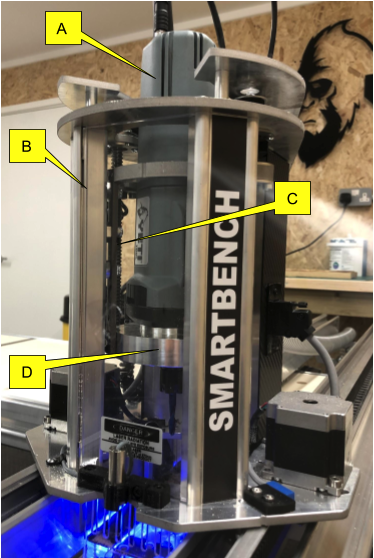This article will give you a quick overview of the SC0 and SC1 spindle motors, and what you will learn from this masterclass.
| List | Next >
The spindle motor is the component mounted in the Z Head that holds and spins the cutting tool.
A: Spindle motor
B: Z Head
C: Spindle cage (this moves up and down in the Z Head)
D: Clamping collar (this holds the spindle motor in place in the cage)

Differences between the SC0 and SC1 spindles
SC1
The SC1 spindle motor has an extra signal cable, so that the SC1 and SmartBench can communicate overload information and speed information to each other.
This enables the Precision and PrecisionPro models of SmartBench to have automatic overload detection and digital spindle speed control.
The SC1 spindle uses an ER16 collet.
SC0
The SC0 spindle uses an OZ collet.
The SC0 spindle motor does not have a signal cable going to SmartBench. This means that the spindle speed must be set manually, and SmartBench has no way of detecting spindle overload.
|

|
The SC0 spindle itself still has built-in overload detection, but it cannot send this information to SmartBench.
This means that it is possible for the SC0 spindle motor to shut-down without SmartBench pausing the job - so be extra mindful of feeds and speeds!
|
What you will learn
This masterclass will take you through the need-to-knows of operating, understanding and maintaining the spindle motor.
However, if you are looking for detailed instructions on tool changing, fitting tools, or spindle maintenance, check out the following guides in other parts of the CNC Academy:
| List | Next >